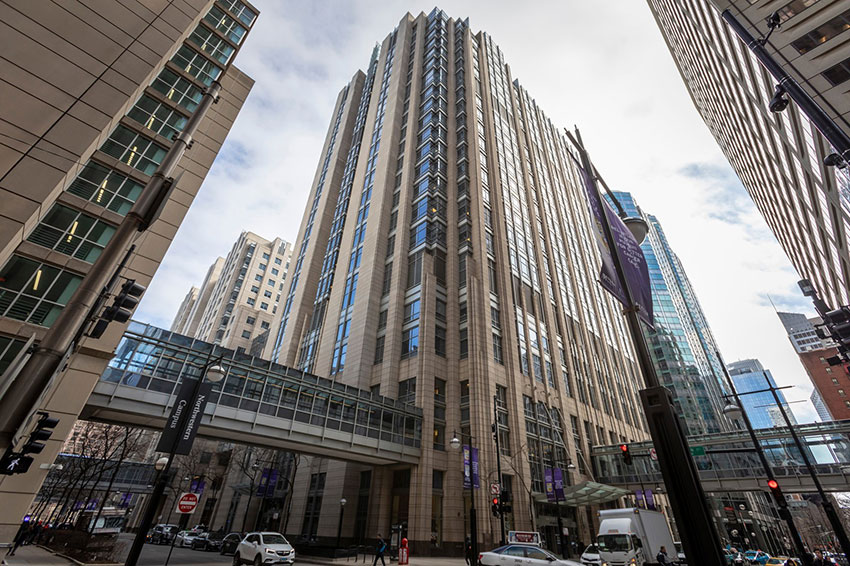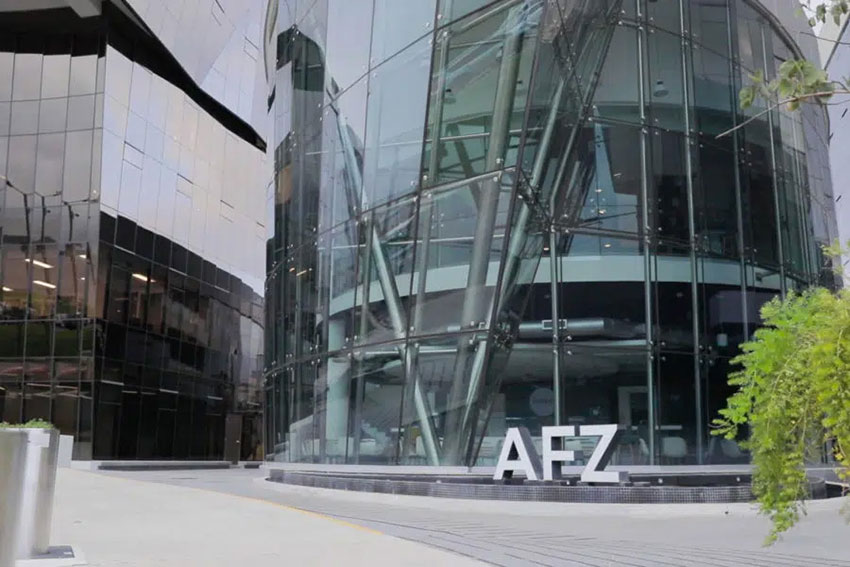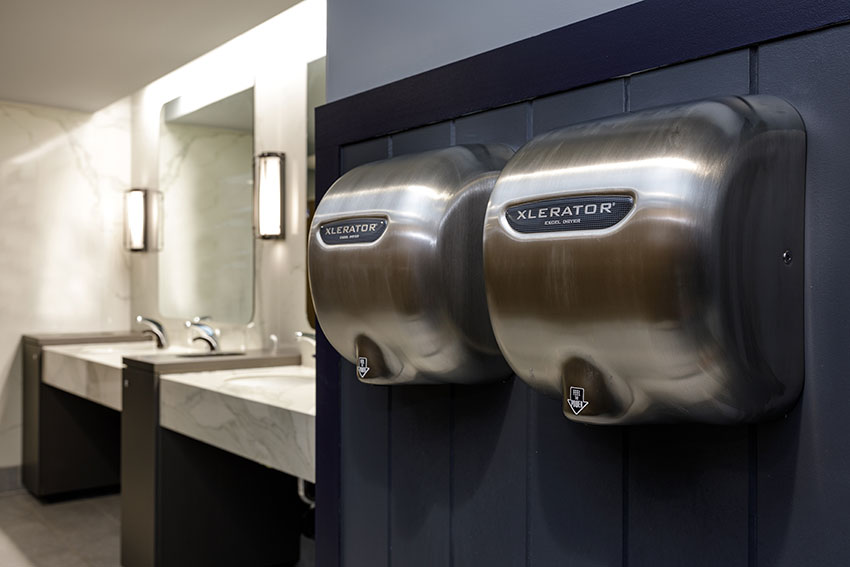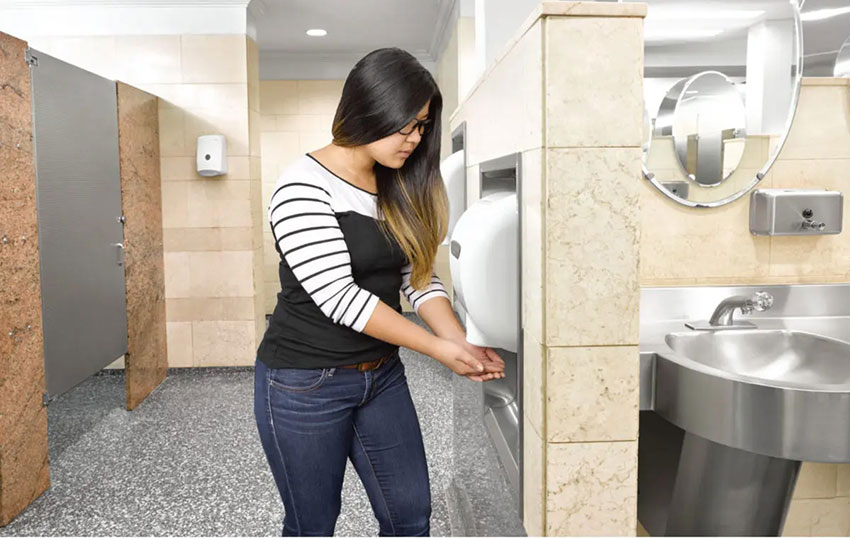Perception of building quality can hinge on the restroom. When comparing the square footage of commercial restrooms to the total square footage of a building, the impact of the space far exceeds its relative size. What words come to mind regarding the last commercial restroom visited? Was it dirty or clean? Cramped or comfortable? Outdated or modern? Wasteful or sustainable? Dangerous or safe? Much depends on the features and amenities provided as well as the level of maintenance. The Covid-19 pandemic thrust the safety of restrooms into sharper focus. This course helps architects consider what it takes to create sustainable and safe restrooms, with a focus on hand-washing, without breaking the bank.
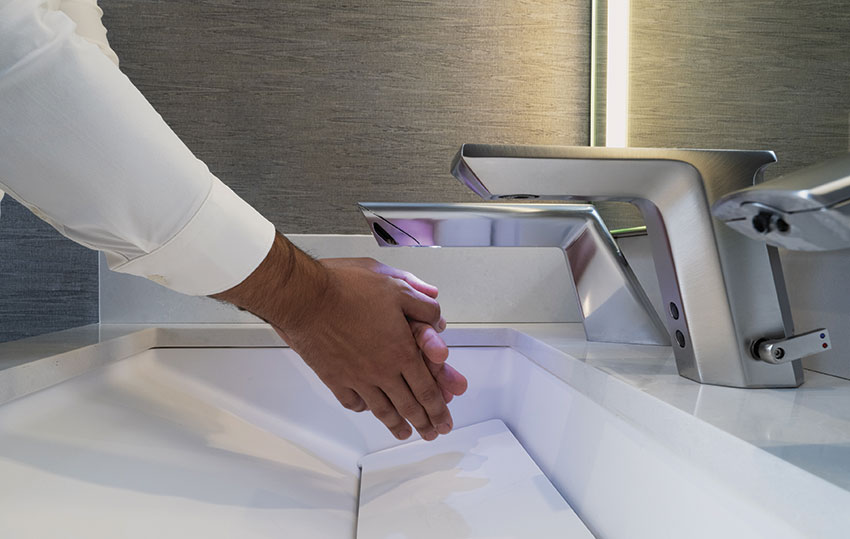
Photo courtesy of Excel Dryer
An integrated system with a touchless faucet and hand dryer in one assembly produces no paper waste and minimizes movement around the restroom in a post-pandemic world.
THE SIGNIFICANCE OF COMMERCIAL RESTROOMS
Restrooms cannot be an afterthought when designing commercial buildings. While they typically only take up 5 percent of a building's total square footage, they have outsized importance. For instance, according to the American Institute of Cleaning Sciences, they account for:
- 40% of the building's whole soil level.
- 50% of occupant complaints.
- 20% of the total labor budget.1
The overall mindset around hygiene is changing—making clean public restrooms more important than ever before. Survey experts MetrixLab conducted a survey in the United States over one week in August 2022.1 The sample included 1,000 respondents, with a mix of adult men and women who had used a public restroom over the past six months.
The survey resulted in several interesting takeaways regarding consumer habits, personal hygiene, and public restroom preferences.
First, nearly 75 percent of consumers wash their hands three to 10 times a day.
- 21% wash hands three to four times a day
- 30% wash hands five to six times per day
- 23% wash hands seven to 10 times a day
Second, the majority of consumers have used a public restroom in the past month.
Third, restaurants are by far the most popular location for using public restrooms.
In a separate study conducted around the same time, MetrixLab gathered data from approximately 350 respondents with a sampling of key stakeholders, including:
- Architects/designers (96)
- Restaurant owners (101)
- Commercial facility managers (156)
When presented with nine restroom features implemented since the beginning of the Covid-19 pandemic, respondents selected increased cleaning protocols and touch-free technology as the biggest changes.
For designers, the focus on commercial restrooms should incorporate occupant safety, sustainability, and savings. This course helps architects consider what it takes to create quality commercial restrooms, with a particular focus on hand-washing, without breaking the bank.
Factors That Impact Commercial Restroom Design
These are the primary considerations that impact commercial restroom design and the questions that should be asked.
Occupants
- How many people will use the restrooms?
- Are there any gender-specific considerations among the anticipated users (i.e., gender-specific dormitories or locker rooms)?
- How will people use the space? Consider the broader context of the area. People use restrooms differently at an airport than at a gym or a school.
- How will accessibility considerations impact the space required, fixture size and height, and accessories (such as grab bars)? While all restrooms must be ADA-compliant, restrooms in a senior living facility will likely require more amenities than those in an office building.
Budget
- What are the initial costs of the restroom? These include materials (building materials, fixtures, and supplies), installation labor, and inspection fees.
- What are the ongoing costs of the restroom? These include maintenance, supplies, and cleaning.
Design Goals
- How do you want people to feel when they enter the space?
- What are the sustainability goals for the building, including third-party certifications, such as LEED, WELL, TRUE Zero Waste, and others?
Maintenance Considerations
- How durable are the fixtures and materials used in the restroom?
- How easy are the fixtures and materials to clean?
- How many required touchpoints are in the space?
- Note: The more touchpoints there are, the more frequent cleaning and disinfection are needed.
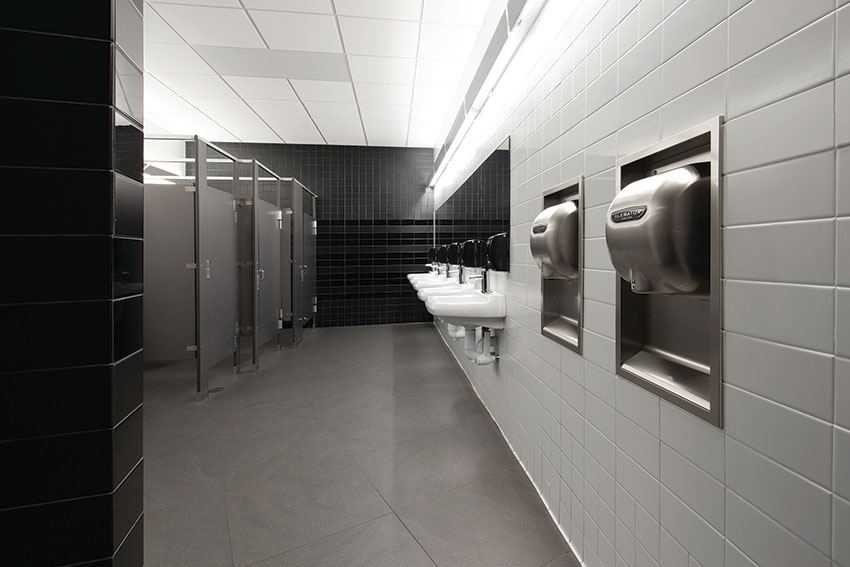
Photo courtesy of Excel Dryer
This commercial restroom conveys cleanliness and safety with a row of touchless sink faucets and high-speed, energy-efficient hand dryers.
Perception of building quality can hinge on the restroom. When comparing the square footage of commercial restrooms to the total square footage of a building, the impact of the space far exceeds its relative size. What words come to mind regarding the last commercial restroom visited? Was it dirty or clean? Cramped or comfortable? Outdated or modern? Wasteful or sustainable? Dangerous or safe? Much depends on the features and amenities provided as well as the level of maintenance. The Covid-19 pandemic thrust the safety of restrooms into sharper focus. This course helps architects consider what it takes to create sustainable and safe restrooms, with a focus on hand-washing, without breaking the bank.

Photo courtesy of Excel Dryer
An integrated system with a touchless faucet and hand dryer in one assembly produces no paper waste and minimizes movement around the restroom in a post-pandemic world.
THE SIGNIFICANCE OF COMMERCIAL RESTROOMS
Restrooms cannot be an afterthought when designing commercial buildings. While they typically only take up 5 percent of a building's total square footage, they have outsized importance. For instance, according to the American Institute of Cleaning Sciences, they account for:
- 40% of the building's whole soil level.
- 50% of occupant complaints.
- 20% of the total labor budget.1
The overall mindset around hygiene is changing—making clean public restrooms more important than ever before. Survey experts MetrixLab conducted a survey in the United States over one week in August 2022.1 The sample included 1,000 respondents, with a mix of adult men and women who had used a public restroom over the past six months.
The survey resulted in several interesting takeaways regarding consumer habits, personal hygiene, and public restroom preferences.
First, nearly 75 percent of consumers wash their hands three to 10 times a day.
- 21% wash hands three to four times a day
- 30% wash hands five to six times per day
- 23% wash hands seven to 10 times a day
Second, the majority of consumers have used a public restroom in the past month.
Third, restaurants are by far the most popular location for using public restrooms.
In a separate study conducted around the same time, MetrixLab gathered data from approximately 350 respondents with a sampling of key stakeholders, including:
- Architects/designers (96)
- Restaurant owners (101)
- Commercial facility managers (156)
When presented with nine restroom features implemented since the beginning of the Covid-19 pandemic, respondents selected increased cleaning protocols and touch-free technology as the biggest changes.
For designers, the focus on commercial restrooms should incorporate occupant safety, sustainability, and savings. This course helps architects consider what it takes to create quality commercial restrooms, with a particular focus on hand-washing, without breaking the bank.
Factors That Impact Commercial Restroom Design
These are the primary considerations that impact commercial restroom design and the questions that should be asked.
Occupants
- How many people will use the restrooms?
- Are there any gender-specific considerations among the anticipated users (i.e., gender-specific dormitories or locker rooms)?
- How will people use the space? Consider the broader context of the area. People use restrooms differently at an airport than at a gym or a school.
- How will accessibility considerations impact the space required, fixture size and height, and accessories (such as grab bars)? While all restrooms must be ADA-compliant, restrooms in a senior living facility will likely require more amenities than those in an office building.
Budget
- What are the initial costs of the restroom? These include materials (building materials, fixtures, and supplies), installation labor, and inspection fees.
- What are the ongoing costs of the restroom? These include maintenance, supplies, and cleaning.
Design Goals
- How do you want people to feel when they enter the space?
- What are the sustainability goals for the building, including third-party certifications, such as LEED, WELL, TRUE Zero Waste, and others?
Maintenance Considerations
- How durable are the fixtures and materials used in the restroom?
- How easy are the fixtures and materials to clean?
- How many required touchpoints are in the space?
- Note: The more touchpoints there are, the more frequent cleaning and disinfection are needed.

Photo courtesy of Excel Dryer
This commercial restroom conveys cleanliness and safety with a row of touchless sink faucets and high-speed, energy-efficient hand dryers.
KEY SAFETY CONSIDERATIONS WITHIN COMMERCIAL RESTROOMS
The most basic safety considerations for commercial restrooms are those set by the Occupational Safety and Health Administration (OSHA), which requires employers to provide all workers with sanitary and immediately-available toilet facilities. The sanitation standard 1910.141 – Sanitation aims to ensure that workers do not suffer adverse health effects that can result if toilets are not clean or available when needed.
That means:
- Toilet facilities must be available at every worksite (except for mobile worksites).
- Employees must have reasonable access to a bathroom facility.
- The number of employees at the worksite determines the number of toilets.
- Each toilet must be in a separate compartment with a door.
- Hand-washing facilities must be provided and maintained in a sanitary condition.
- All restrooms are required to have running water, soap, and hand towels or air dryers.
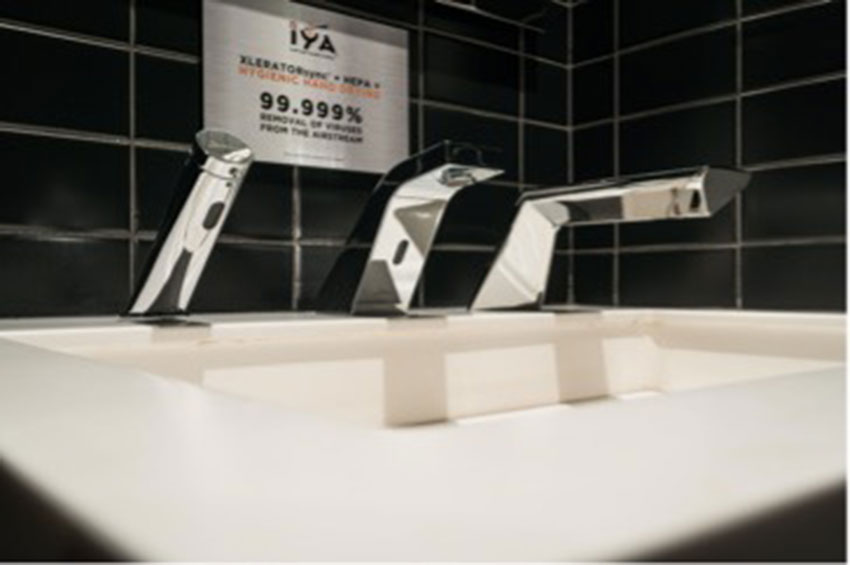
Photo courtesy of Excel Dryer
The integration of soap, water, and a dryer in one assembly impressed Andy Yee, principal managing partner of Bean Restaurant Group.
The Impact of COVID-19 on Restroom Safety
Commercial and public restrooms impact a large portion of the population. Because of the COVID-19 pandemic, we're more aware of germs than ever. These are strategies some people take to avoid germs in restrooms:
- Operate the flusher with a foot.
- Use a seat liner.
- Hover over the toilet seat.
- Open or close doors with the body rather than the hands.
Building owners and managers have invested in significant retrofits to address pandemic safety concerns.
Reducing Touchpoints
One of the essential safety modifications in restrooms is reducing the number of critical touchpoints. Both restroom fixtures and doors can be a source of required touchpoints. According to the American Restroom Association (ARA): "Not everyone washes their hands after using the toilet. Those that do should not be required to touch potentially unclean surfaces after scrubbing their hands. Restroom doors should be designed so that after one has washed their hands, exit is possible without touching a surface."2
Also, each touchpoint requires frequent cleaning and disinfection, so removing touchpoints lowers overall maintenance needs. The good news is that solutions are available today to address this safety concern.The ARA notes, "Automated devices reduce the spread of disease and cost by controlling product usage." Touch-less and automated devices include:
- Door openers
- Toilet flusher
- Faucets
- Liquid soap dispensers
- Hand dryers
- Paper towel dispensers
- Toilet paper dispensers
Particularly on commodes, the ARA noted, "It is important that the sensor be installed so that it does not prematurely initiate the flush cycles. Wall sensors that detect movement away from the fixture may be less likely to falsely activate."
Hand Dryers or Paper Towels?
In every commercial restroom design, the choice arises between hand dryers or paper towels. According to the World Health Organization, both are efficient: "Once your hands are cleaned, you should dry them thoroughly using paper towels or a warm air dryer."3 A study by the University of Arizona Health Sciences found that "the breadth of available data does not favor one hand-drying method as more hygienic or safer than the other."4,5 Instead, the specification of air dryers vs. paper towels and dispensers typically focuses on operating costs, maintenance costs, and sustainability.
Integrated Sink Systems Pull it All Together
As perhaps the gold standard for touchless fixtures, an integrated sink system provides touchless access to the faucet, soap, and hand dryer all in one unit. In addition to reducing the required touchpoints, these systems address other safety concerns by avoiding water on the ground and reducing the circulation path. This assembly impressed Andy Yee, Principal Managing Partner of Bean Restaurant Group, which operates more than a dozen restaurants. "It's a good blend into our industry," Yee says of the integrated sink system. "It's all touchless—soap, wash, dry. You eliminate the C-fold towels. There's no trash around the bathroom anymore."
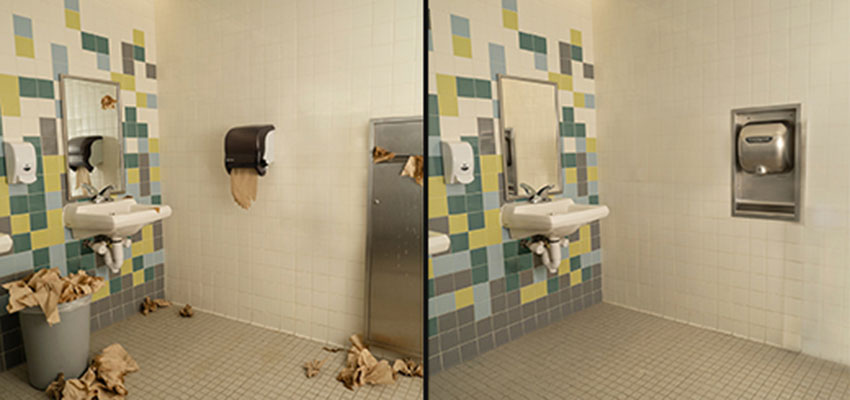
Photo courtesy of Excel Dryer
Commercial restrooms changed as a result of the pandemic.
Commercial Restrooms Before and After the Pandemic
Here's a glance at a typical before and after in a commercial restroom. Notice the differences between these two illustrations.
- Before the pandemic, the typical restroom had a standard sink with hot and cold-water handles, a soap dispenser next to the sink, and a paper towel dispenser either adjacent or across the room. To address COVID-19 safety concerns, the building operators upgraded the restroom to include an integrated sink system that offers touchless hand washing and drying without requiring users to walk back and forth across the restroom. There is no longer a trash receptacle filled with paper waste.
- Before the pandemic, restrooms had a door with a knob that required users to touch the doorknob to enter and exit the space. Automatic doors, or no-door designs, are now a more common solution to address COVID-19 safety concerns, removing a critical touchpoint.
- Before the pandemic, restrooms typically had manual-flush toilets, which many users used their feet to operate. These required frequent disinfecting. To address COVID-19 safety concerns, a sensor valve flushes the toilet without requiring physical contact, removing another critical touchpoint.
Accommodating Social Distancing
Another critical safety concern raised by the COVID-19 pandemic is the ability of a restroom to accommodate social distancing and avoid clusters of people gathering. Several strategies exist to address this, including the integrated sink system. Another approach is modifying the restroom layout with separate entrance and exit doors, which reduces close interaction through an efficient circulation path that gets people in and out.
Prioritizing Ventilation and Filtration
COVID-19 also increased focus on ventilation and filtration as safety considerations. According to the Centers for Disease Control and Prevention (CDC): "When indoors, ventilation mitigation strategies can help reduce viral particle concentration. The lower the concentration, the less likely viral particles can be inhaled into the lungs (potentially lowering the inhaled dose); contact eyes, nose, and mouth; or fall out of the air to accumulate on surfaces.
Protective ventilation practices and interventions can reduce the airborne concentrations and the overall viral dose to occupants."6 Exhaust fans should be functional and operate at full capacity when the building is occupied.
A higher standard is reached via hand dryers with built-in HEPA filtration. These dryers remove 99.999 percent of viruses from the airstream, blowing clean, warm air onto hands to dry them quickly and efficiently. This value is based on testing performed by LMS Technologies in 2023.7
The WELL Health-Safety Rating for Building Operation
In light of the COVID-19 pandemic, the International WELL Building Institute (IWBI) convened more than 600 experts to form the Task Force on COVID-19. Expanding on strategies from the WELL Building Standard, IWBI launched the WELL Health-Safety Rating for Facility Operations and Management in 2020. This rating helps building operators and organizations address occupants' health, safety, and well-being in their spaces. The rating also indicates to everyone entering a space that evidence-based measures have been adopted and third-party verified.
The WELL Health-Safety Rating is for operating buildings and spaces (not their initial design and construction). The rating includes more than 20 strategies (referred to as "features") across the following categories (referred to as "concepts"):
- Cleaning and Sanitization Procedures
- Emergency Preparedness Programs
- Health Service Resources
- Air and Water Quality Management
- Stakeholder Engagement/Communication
No single strategy is required. Instead, projects must meet a minimum of 15 total (spread across categories as they see fit).
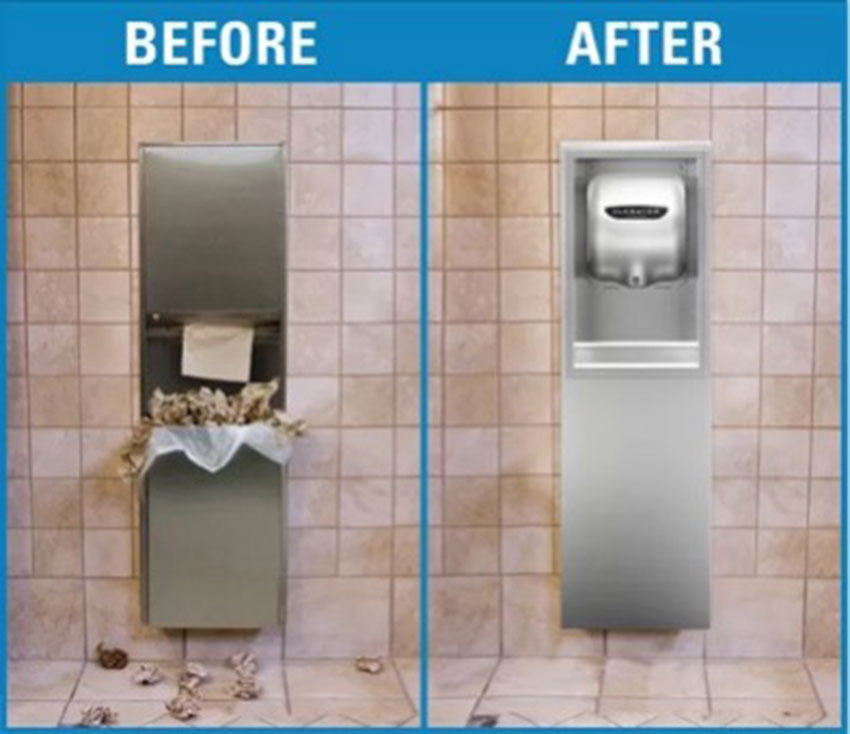
Photo courtesy of Excel Dryer
Kits are made for retrofitting existing paper towel dispensers and trash receptacles with ADA-compliant hand dryers.
High-Speed, Energy-Efficient Hand Dryers Support Features in the WELL Health-Safety Rating
Certain high-speed, energy-efficient (HSEE) hand dryers can contribute to third-party certifications like the WELL Health-Safety Rating.
Here are the relevant features:
- Support Hand-washing: This feature requires spaces to improve hygiene by offering soap containers and hand-drying support. It specifies acceptable methods for hand drying, including hand dryers equipped with a HEPA filter.
- Reduce Surface Contact:This feature requires spaces to assess high-touch surfaces throughout the project and implement temporary and/or permanent strategies to reduce the frequency or need for hand touch. As previously discussed, integrated sink systems with high-speed, energy-efficient hand dryers can reduce the required touchpoints in a restroom.
- Improve cleaning practices: This feature requires designers of spaces to develop cleaning and disinfection plans, including instructions, training, and recordkeeping. HSEE hand dryers may contribute to this feature by reducing the number of touchpoints that need to be disinfected, freeing up custodial time by reducing custodial tasks such as replacing paper towels and removing paper towel waste.
ADA Considerations
ADA compliance is a hot topic today, but creating physical locations designed to provide an equivalent experience to every user regardless of physical limitations is not a new concept. The Americans with Disabilities Act (ADA) was created in the 1990s to prevent discrimination and ensure all Americans could easily access public spaces. The ADA significantly impacted architects, causing them to adapt their designs to meet rigorous criteria.
Public restroom guidance includes:
- Ample space so that a single wheelchair can rotate 180 degrees.
- 60-inch width minimum toilet space, with the seat falling between 17 to 19 inches from the toilet base.
- Smooth, easy-to-hold grab bars installed along bathroom walls, especially near toilets.
- Sinks or countertops no more than 34 inches high, with space beneath for acceptable knee clearance.
- Faucets must be workable with only one hand.
- Hand dryers should be motion-activated and shouldn't extend more than 4 inches from the wall.
Selecting a hand dryer is often the final piece of the puzzle, and finding a model that fits the ADA criteria and is well-designed can be challenging.
FAQ—ADA-Compliant Hand Dryers
Q: What makes a hand dryer ADA-compliant?
A: For a hand dryer to be ADA-compliant, the appliance must be motion-activated and not protrude more than 4 inches from the wall.
Q: What is the ADA height for a hand dryer?
A: To be ADA compliant, all buttons and touch-free sensors on the hand dryer must fall between a height of 38 inches to 48 inches off the floor.
SUSTAINABILITY CONSIDERATIONS WITHIN COMMERCIAL RESTROOMS
This section discusses water use, energy use, materials use, indoor air quality, and operations of commercial restrooms. Water
Creating water-saving restrooms addresses both environmental issues and cost savings. Water is likely the first thing that comes to mind when considering commercial restroom sustainability because it has a significant impact. The EPA states that "commercial and institutional buildings can account for 17 percent of the municipal water demand in the United States."8
Strategies to reduce water use include:
- Replacing or retrofitting toilets (with high-efficiency or dual-flush models)
- Replacing or retrofitting urinals (with waterless models)
- Replacing or retrofitting faucets (with high-efficiency aerators or sensor-based)
- Using alternate sources of water (such as graywater for flushing), and
- Tracking water use and leaks
Energy
Energy use goes hand in hand with water use reduction because of the energy required to pump, heat, treat and move water. Less water use means less energy use.
Strategies for reducing energy use in commercial restrooms include:
- Installing energy-efficient lighting.
- Installing high-speed, energy-efficient hand dryers, which use 80 percent less energy than conventional dryers.
The latest version of the LEED rating system for new construction heavily emphasizes energy reduction. Projects must meet minimum energy performance requirements and can earn up to 18 points by further optimizing energy performance. This equals the single largest potential credit in LEED.
Prerequisite: Minimum Energy Performance and Credit Optimize Energy Performance
This prerequisite and credit require projects to show how the building will reduce its energy use compared to a typical building. Certain high-speed, energy-efficient hand dryers may contribute to this credit as energy efficiencies associated with the dryer contribute to a reduction in proposed building energy use.
Materials
Material use in commercial restrooms concerns both the materials in the restroom and the waste generated by ongoing use. Design decisions can significantly impact the ongoing material use of a commercial restroom. For example, designing a restroom with paper towel dispensers rather than hand dryers means that for the life cycle of the restroom, the building operator must supply paper towels. This is especially concerning, given that in October 2021, the National Resources Defense Council gave several popular paper towel brands an "F" on sustainably due to their reliance on virgin paper.9 Sustainability in materials encapsulates their complete life cycle: from the extraction of raw materials to manufacturing to transportation and distribution to use to end-of-life management.
Several tools are available for selecting more sustainable materials:
- Life Cycle Assessment (LCA): An LCA investigates a product's total environmental impact from the time of manufacture (Beginning of life) to the time of disposal (End of life)
- Environmental Product Declaration (EPD): An EPD is a standardized way of quantifying the environmental impact of a product by studying the raw materials and energy consumption during its production, use, and disposal. For buyers and specifiers, the EPDs are a disclosure tool that helps purchasers better understand a product's sustainable qualities and environmental repercussions so they can make more informed product selections.
- Health Product Declaration (HPD): An HPD is a standardized format for the transparent disclosure of building product ingredients and associated hazards. HPDs are a tool that helps buyers and specifiers better understand the environmental and health impacts of a product's materials to make more informed product selections.
HSEE Hand Dryers Support Credits in the LEED v4.1* Rating System
The latest version of the LEED rating system for Existing buildings contains several relevant parts (called credits) related to occupant safety and satisfaction that certain high-speed energy efficient hand dryers may contribute to. Let's look at an example: The Green Cleaning credit requires spaces to conduct a Custodial Effectiveness Assessment. Certain high-speed, energy-efficient hand dryers may contribute to this credit by reducing custodial tasks, including replacing paper towels and removing paper towel waste.
TRUE Zero Waste
The final sustainability program we will discuss is TRUE Zero Waste. TRUE Zero Waste certification program enables facilities to define, pursue and achieve their zero waste goals, cutting their carbon footprint and supporting public health.
Like LEED, TRUE Zero Waste allows projects to earn points by achieving credits across various categories. For example:
- TRUE Zero Waste stands for Total Resource Use and Efficiency and was launched in 2013.
- TRUE Zero Waste is a whole-systems approach to change how materials flow through society, resulting in no waste. TRUE Zero Waste encourages redesigning resource life cycles to reuse all products.
- The TRUE Zero Waste Rating System applies to physical facilities and their operations.
- Minimum program requirements must be met (including diverting 90 percent of waste from the landfill), and then optional credits can be earned toward certification. Different levels of certification are available: Certified, Silver, Gold, and Platinum.
- Credits in the rating system are organized into 15 categories. All credits are optional; however, 31 credit points must be earned for a project to achieve certification.
Let's explore several credits that certain high-speed energy-efficient dryers may contribute to.
- Right Size Collection Containers and Service Levels: This credit requires projects to evaluate all containers to ensure appropriate sizes and schedules are in place. Replacing paper towels with high-speed energy efficient hand dryers may contribute to this credit by reducing the size of waste bins needed in restrooms due to the elimination of paper towel waste.
- Document Materials Reduced by Commodity: This credit requires projects to identify at least one material that is being reduced and document the reduction. Replacing paper towels with high-speed, energy-efficient hand dryers may contribute to this credit by eliminating paper towel waste.
- Diversion: This credit requires projects to divert at least 90 percent of their waste from the landfill. Replacing paper towels with high-speed, energy-efficient hand dryers may contribute to this credit by eliminating paper towel waste.
- Carbon Footprint: A related sustainability topic to consider is the carbon footprint or the total amount of greenhouse gases (including carbon dioxide and methane) generated by a space. All the topics just covered (water, energy, and materials) contribute to the carbon footprint of a commercial restroom.
Indoor Air Quality
The final sustainability topic in this course is indoor air quality, which directly impacts occupant health and well-being. Restrooms, in particular, contain several potential pollutants, including excess moisture and biological contaminants. And even some pollutants where you might not expect it: a study found 17 species of bacteria on paper towels. This pilot study concluded that a large number of culturable bacteria, including toxin producers, can be isolated from unused paper towels.11
"This pilot study demonstrated that a large community of culturable bacteria, including toxin producers, can be isolated from unused paper towels and that they may be transferred to individuals after hand-washing. This may have implications in some industrial and clinical settings as well as in immunocompromised individuals."
There are several strategies to improve indoor air quality in commercial restrooms, including:
- Source control (not bringing in products that contain toxins).
- Moisture control (ensuring appropriate humidity levels).
- Cleaning (on a regular basis, using green cleaning best practices).
- Ventilation.
Key ventilation strategies include:
- Ensuring sufficient ventilation rates.
- Installing and using exhaust fans that are vented outdoors in bathrooms.
- Selecting fixtures, such as hand dryers, with built-in HEPA filtration.
OPPORTUNITIES FOR COST SAVINGS WHEN DESIGNING COMMERCIAL RESTROOMS
Sustainability will be a hard sell for developers if profits are negatively affected. The ideal scenario ties sustainable products and systems to long-term cost savings.
Water
Many of the sustainability techniques covered in the last section translate directly into monetary savings. For example, saving water saves money. Water costs and wastewater fees have risen faster than the Consumer Price Index (CPI) in the previous two decades.12 This makes saving water more important than ever.
Energy
Similarly, saving energy saves money. According to one analysis, the average energy cost for commercial buildings is $2.10 per square foot.13 The U.S. Environmental Protection Agency calculates that 30 percent of the energy used in commercial buildings is wasted. Less waste means more profits.14
Materials Durability
While not as immediate as water and energy savings, considering the durability of materials can pay off in the long term. The more often materials are replaced, the higher the cost.
Ongoing Costs of Consumables
Ongoing consumables refer to materials that are regularly used and replaced throughout the course of doing business. Commercial restrooms contain several ongoing consumables: toilet paper, seat covers, sanitary products, trash bag liners, and in some cases, paper towels. The cost of ongoing consumables adds up as items must be continually restocked. When the cost of a single case of paper towels is considered, along with delivery, freight, tax, and handling charges, it becomes clear why switching to high-speed energy efficient hand dryers and eliminating paper towels offers a significant cost savings opportunity.
Waste Hauling
The next consideration is what happens to all those ongoing consumables after use. Of course, they are thrown away. Waste hauling is a significant cost in operating a commercial building. Depending on the area of the country, disposal costs can range from $20 per ton to more than $100 per ton. This is another area where eliminating paper towels can save money by reducing the waste that needs disposal.
Maintenance Costs
Finally, maintenance costs in commercial restrooms should be considered. We learned earlier that commercial restrooms play an outsized role in soil level and occupant complaints. These relate to the maintenance of those restrooms. When making design decisions, it's essential to consider their impact on ease of cleaning and maintenance. When facility staff must spend time on clogged plumbing systems, for example, when a user flushes paper towels, the staff is diverted from other vital tasks, like sanitizing high-touch surfaces.
Labor Costs
Labor costs should be factored in when considering commercial restroom maintenance. Anecdotally speaking, an overflowing trash receptacle is a blatant sign of maintenance shortcomings. And because of behavior changes post-pandemic, building occupants and patrons are washing their hands more frequently. Consequently, discarded paper towels add up. But trouble ensues when the need for more frequent restroom cleaning butts up against a labor shortage. In some cases, there is inadequate labor to accommodate "the paper cycle," leading to empty dispensers, full trashcans, and bad patron experiences.
CONCLUSION
The design of commercial restrooms impacts the functionality of the building and user perception. Emphasis needs to be on safety, sustainability, and savings. Especially post-pandemic, there is more hand-washing and more use of commercial restrooms. To minimize touchpoints where infectious diseases can be spread, facilities have been upgraded to include touchless toilet flushers, faucets, soap dispensers, and high-speed, energy-efficient hand dryers. Eliminating paper towels and the associated waste can help the bottom line. Giving the users of commercial restrooms a trouble-free and sanitary experience is more important than ever.
END NOTES
1Kovacs, Steve. “Best Practices to Establish an Effective Restroom Sanitation Program.” Blog post. P&G Professional. 2020. Web. 10 May 2023.
2“Public Restroom Design Issues.” American Restroom Association. Web. Accessed 10 May 2023.
3“Coronavirus disease (COVID-19) advice for the public: Mythbusters." World Health Organization. 19 January 2022. Web. 18 May 2023.
4“Paper Towels vs. Air Hand Dryers: UArizona Health Sciences Researchers Evaluate Effectiveness of Both Hand-Drying Methods.” The University of Arizona Health Services. 8 September 2020. Web. Accessed 18 May 2023.
5Reynolds, K.A., Sexton, J.D., Norman, A. and McClelland, D.J. (2021). “Comparison of electric hand dryers and paper towels for hand hygiene: a critical review of the literature.” J. Appl. Microbiol., 130: 25-39. Web. Accessed 18 May 2023.
6“Ventilation in Buildings.” Centers for Disease Control and Prevention. Updated 12 May 2023. Web. Accessed 18 May 2023.
7“99.999% Removal of Viruses from the Air Stream: Based on testing performed by LMS Technologies, 2020.” Excel Dryer. Web. Accessed 18 May 2023.
8“Best Management Practices for Commercial and Industrial Facilities.” U.S. Environmental Protection Agency. Accessed Web. 18 May 2023.
9“The Issue with Tissue 2021 Scorecard.” Natural Resources Defense Council. September 2021. Web. Accessed 18 May 2023.
10 “U.L. Environment PCR—Hand Dryers.” Excel Dryer. Web. Accessed 18 May 2023.
11Gendron LM, Trudel L, Moineau S, Duchaine C. “Evaluation of bacterial contaminants found on unused paper towels and possible post contamination after handwashing: a pilot study.” Am J Infect Control. March 2012. Web. Accessed 18 May 2023.
12“NACWA Cost of Clean Water Index.” The National Association of Clean Water Agencies. 2018. Web. Accessed 18 May 2023.
13“What Is the Average Utility Cost per Square Foot of Commercial Property?” Iota Communications. 23 July 2020. Web. Accessed 18 May 2023.
14“About the Commercial Buildings Integration Program.” Office of Energy Efficiency & Renewable Energy. U.S. Dept. of Energy. Web. Accessed 18 May 2023.
Kathy Price-Robinson is a nationally known remodeling and construction writer. Her award-winning remodeling series titled Pardon Our Dust ran 12 years in the Los Angeles Times.





